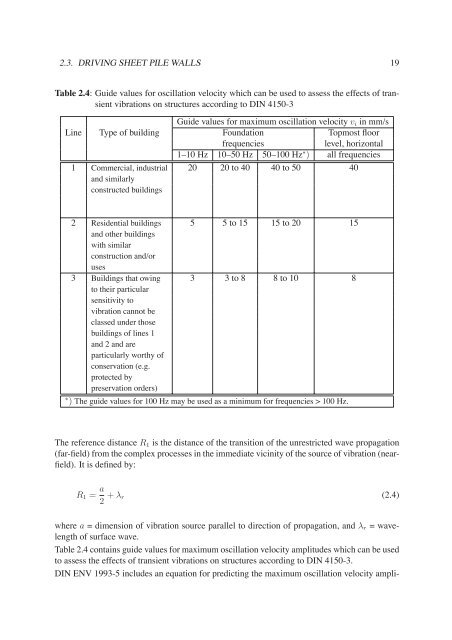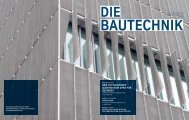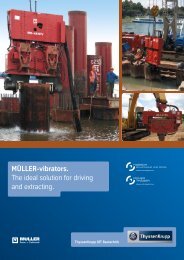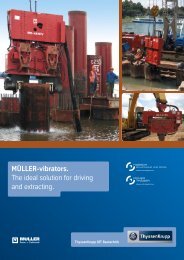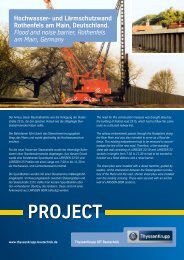pdf (3.6 MB) - ThyssenKrupp Bautechnik
pdf (3.6 MB) - ThyssenKrupp Bautechnik
pdf (3.6 MB) - ThyssenKrupp Bautechnik
You also want an ePaper? Increase the reach of your titles
YUMPU automatically turns print PDFs into web optimized ePapers that Google loves.
2.3. DRIVING SHEET PILE WALLS 19<br />
Table 2.4: Guide values for oscillation velocity which can be used to assess the effects of transient<br />
vibrations on structures according to DIN 4150-3<br />
Guide values for maximum oscillation velocity vi in mm/s<br />
Line Type of building Foundation Topmost floor<br />
frequencies level, horizontal<br />
1–10 Hz 10–50 Hz 50–100 Hz ∗ ) all frequencies<br />
1 Commercial, industrial 20 20 to 40 40 to 50 40<br />
and similarly<br />
constructed buildings<br />
2 Residential buildings 5 5to15 15 to 20 15<br />
and other buildings<br />
with similar<br />
construction and/or<br />
uses<br />
3 Buildings that owing 3 3to8 8to10 8<br />
to their particular<br />
sensitivity to<br />
vibration cannot be<br />
classed under those<br />
buildings of lines 1<br />
and 2 and are<br />
particularly worthy of<br />
conservation (e.g.<br />
protected by<br />
preservation orders)<br />
∗ ) The guide values for 100 Hz may be used as a minimum for frequencies > 100 Hz.<br />
The reference distance R1 is the distance of the transition of the unrestricted wave propagation<br />
(far-field) from the complex processes in the immediate vicinity of the source of vibration (nearfield).<br />
It is defined by:<br />
R1 = a<br />
+ λr<br />
(2.4)<br />
2<br />
where a = dimension of vibration source parallel to direction of propagation, and λr =wavelength<br />
of surface wave.<br />
Table 2.4 contains guide values for maximum oscillation velocity amplitudes which can be used<br />
to assess the effects of transient vibrations on structures according to DIN 4150-3.<br />
DIN ENV 1993-5 includes an equation for predicting the maximum oscillation velocity ampli-


